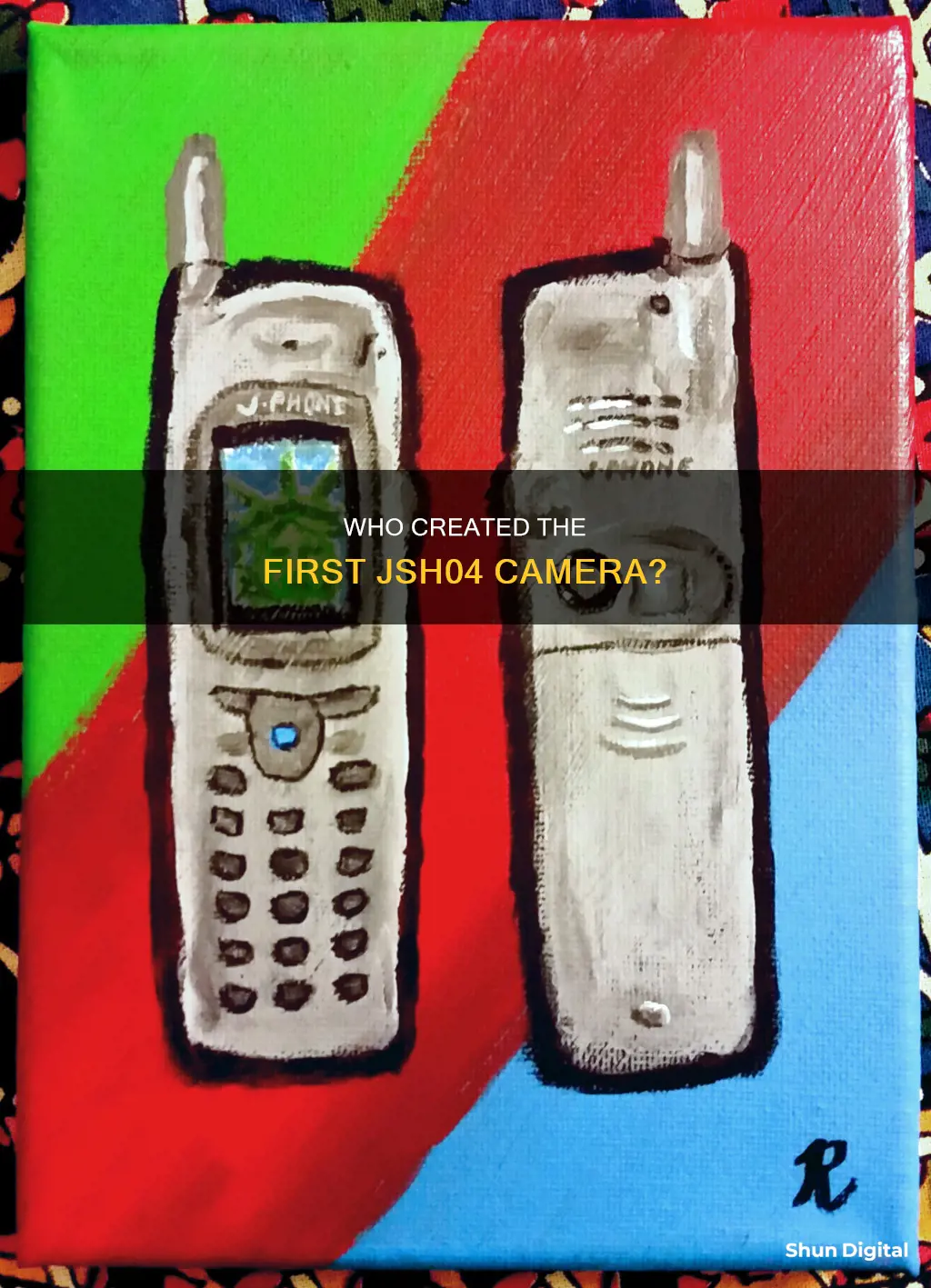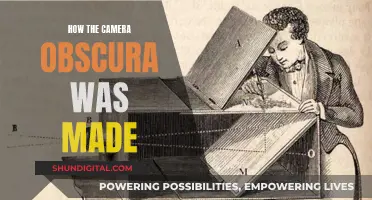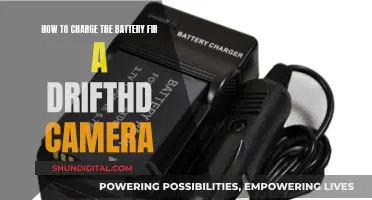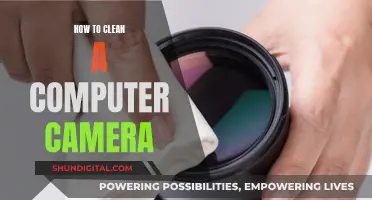
The J-SH04, made by Sharp Corporation and released by J-Phone (SoftBank Mobile) in Japan in November 2000, is considered the world's first cellular-enabled camera phone. The phone featured a 110,000-pixel (0.11-megapixel) CMOS imaging sensor (camera) and a 256-colour display. It weighed 74g and measured 127 x 39 x 17mm. The J-SH04 was Japan's second phone with a built-in, back-facing camera and is credited with popularising the concept of a camera phone.
| Characteristics | Values |
|---|---|
| Company | Sharp Corporation |
| Released by | J-Phone (SoftBank Mobile) |
| Release date | November 2000 |
| Region | Japan |
| Camera resolution | 110,000 pixels (0.11 megapixels) |
| Display | 256 colours |
| Weight | 74g |
| Dimensions | 127 x 39 x 17 mm |
| Successor | J-SH05 flip phone |
What You'll Learn

The J-SH04 was released in November 2000 by Sharp Corporation
The J-SH04, released in November 2000, was a mobile phone with a built-in camera. Manufactured by Sharp Corporation and released by J-Phone (SoftBank Mobile), it was the world's first cellular-enabled camera phone.
The J-SH04 was initially offered to Japan's biggest mobile network operators, NTT DoCoMo and KDDI, but both companies rejected the idea of a camera phone. Sharp then approached J-Phone, the smallest operator, and although the marketing team was less convinced, a compromise was reached. J-Phone placed an order for 10,000 units, with only 2,000 of them featuring a camera. The camera variant sold out within two weeks, and J-Phone immediately recognised the popularity of having a camera integrated into a phone.
The J-SH04 featured a 110,000-pixel CMOS imaging sensor (0.11-megapixel) and a 256-colour display. Weighing just 74g, the phone measured 127 x 39 x 17 mm. It was only available in Japan and was succeeded by the J-SH05 flip phone, which was released a month later.
The J-SH04 was a transformational moment for the camera phone. It popularised the concept of a camera phone, branded as Sha-Mail, and was the world's first fully integrated camera and telephone over a cellular mobile network. It allowed users to instantly transmit pictures via cell phone telecommunication and was the first phone that allowed users to send images electronically. The phone's Sha-mail picture messaging service quickly became an international reference for the potential of picture sharing.
While the J-SH04 was not the first phone with a camera, it was the first to fully integrate the camera with the phone function. The Kyocera VP-210, released in September 1999, was the first commercial mobile camera phone, but it was a DECT-based PHS device rather than a cellular device. The Samsung SCH-V200, released several months before the J-SH04, featured a camera inside the same case as the phone, but it was not fully integrated as photos had to be transferred to a PC to be sent over a network.
After Effects Camera Modes: Choosing the Right One
You may want to see also

It was the world's first cellular-enabled camera phone
The J-SH04, manufactured by Sharp Corporation and released by J-Phone (SoftBank Mobile) in November 2000, is considered the world's first cellular-enabled camera phone. The phone featured a 110,000-pixel (0.11-megapixel) CMOS imaging sensor, and was only available in Japan.
The J-SH04 was not the first phone with a built-in camera, but it was the first with a fully integrated camera and telephone over a cellular mobile network. The phone's camera was designed to take photos facing away from the user, which was a more popular way to use digital cameras at the time than video calling and selfies. However, Sharp had initially struggled to find a mobile network operator that was interested in the idea of a camera phone. NTT DoCoMo, Japan's biggest mobile network operator, and KDDI, the second biggest, both rejected the idea. Eventually, J-Phone, the smallest operator at the time, agreed to place an order of 10,000 units, although only 2,000 of these were the camera variant of the product. The camera variant of the J-SH04 sold out within two weeks, while the non-camera variant remained on the shelves, quickly demonstrating the popularity of having a camera integrated into a phone.
The J-SH04's Sha-mail picture messaging service became an international reference for the potential of picture sharing. The phone also included a tiny mirror next to the camera lens to help users frame self-portraits, or selfies. Additionally, users could send images to anyone else who had the same phone using the SkyMail service, which influenced Bluetooth file transfers and AirDrop transfers on iPhones.
The J-SH04 had its predecessors. In December 1997, Kyocera released the VP-110, a PCMCIA videophone adapter with an 80,000-pixel CCD camera that attached to the DataScope DS-110 and DS-320 mobile phones. Kyocera then released the first commercial mobile camera phone in September 1999, the VP-210 Visual Phone, which had a front-facing 110,000-pixel CMOS camera enabling both video calling and sending photos over the air. Samsung's SCH-V200 phone, equipped with a VGA camera, was released in South Korea several months before the J-SH04, but the camera was not integrated with the phone function and photos had to be transferred to a PC to be sent over a network.
The Contax G2 Camera: A History of its Evolution
You may want to see also

It was only available in Japan
The J-SH04 was a mobile phone with a built-in camera, released in November 2000. It was manufactured by Sharp Corporation and sold by J-Phone (now known as SoftBank Mobile). Interestingly, it was only available in Japan.
Sharp initially offered the J-SH04 to Japan's biggest mobile network operator, NTT DoCoMo, but they rejected the idea of a camera phone. KDDI, the second biggest network, also turned down the offer. Finally, Sharp approached J-Phone, the smallest operator at the time. The engineers at J-Phone liked the idea, but the marketing team was less convinced due to the small screen and low-resolution camera. A compromise was reached, and J-Phone placed an order for 10,000 units, with only 2,000 of them being the camera variant.
The J-SH04 was Japan's second phone with a built-in camera, and it proved to be a huge success. It had a 110,000-pixel CMOS image sensor and a 256-color display. The phone weighed just 74g and had dimensions of 127 x 39 x 17 mm. It was replaced by the J-SH05 flip phone just a month after its release.
The J-SH04 played a pivotal role in popularising the concept of a camera phone. Although it was only available in Japan, its impact was felt worldwide. It was branded as Sha-Mail and was considered a transformational moment for the camera phone. It was the world's first fully integrated camera and telephone over a cellular mobile network, allowing users to instantly transmit pictures via cell phone telecommunication.
The J-SH04 also had a tiny mirror next to the camera lens, enabling users to frame self-portraits or selfies. Additionally, users could send images using the SkyMail service, electronically transferring pictures to anyone else with the same phone. This feature paved the way for Bluetooth file transfers and AirDrop on iPhones.
While the J-SH04 was a groundbreaking innovation in Japan, it had some predecessors. In 1997, Kyocera released the VP-110, a PCMCIA videophone adapter with an 80,000-pixel CCD camera. Kyocera also released the first commercial mobile camera phone, the VP-210, in 1999. The VP-210 had a front-facing 110,000-pixel CMOS camera, enabling both video calling and photo sharing. However, the J-SH04's back-facing camera aligned with the more popular way of using digital cameras at the time, which was to take photos facing away from the user rather than selfies or video calls.
In summary, the J-SH04 camera phone, exclusively available in Japan, was a pioneering device that revolutionised the mobile phone industry. Its impact extended beyond Japan, shaping the future of camera phones and photography worldwide.
How to Keep Your WiFi Camera Charged and Ready
You may want to see also

The J-SH04 had a 110,000-pixel camera
The J-SH04, released in November 2000, was a mobile phone with a built-in camera. It was developed by the Sharp Corporation and released by J-Phone (SoftBank Mobile). The J-SH04 was only available in Japan and was the country's second phone with a built-in, back-facing camera.
The J-SH04's camera had a 110,000-pixel resolution, which was a significant advancement in technology at the time. This resolution is equivalent to 0.11 megapixels and was likely the most advanced piece of technology 20 years ago. While the J-SH04 was not the first camera phone, with the Kyocera VP-210 and the Samsung SCH-V200 preceding it, it was the first cellular-enabled camera phone.
The J-SH04's camera was designed to take photos away from the user, which was a more popular way to use digital cameras at the time than video calling and selfie-taking. The phone also featured a tiny mirror next to the camera lens, allowing users to frame self-portraits or selfies. This forward-thinking design demonstrates that the creators of the J-SH04 were already considering the potential for selfie-taking with their device.
The J-SH04 played a pivotal role in popularising the concept of a camera phone. Its Sha-Mail picture messaging service became an international reference for the potential of picture sharing. The success of the J-SH04 and its impact on the evolution of camera phones cannot be overstated.
Master Erasing Adjustment Brushes in Camera Raw
You may want to see also

It was the first phone to allow users to send images electronically
The J-SH04 was a mobile phone made by Sharp Corporation and released by J-Phone (SoftBank Mobile) in Japan in November 2000. It was the world's first cellular-enabled camera phone and featured a 110,000-pixel CMOS imaging sensor.
While the J-SH04 was not the first phone with a camera, it was the first to fully integrate the camera with the phone and allow users to send images electronically. This was a transformational moment for the camera phone, paving the way for how we take and share pictures today.
Prior to the J-SH04, several other phones with image-capturing capabilities were released. In December 1997, Kyocera released the VP-110, a PCMCIA video phone adapter with an 80,000-pixel CCD camera that attached to the DataScope DS-110 and DS-320 mobile phones. Kyocera then released the first commercial mobile camera phone, the VP-210, in September 1999. The VP-210 had a 110,000-pixel CMOS camera that enabled both video calling and sending photos over the air as mail attachments. However, unlike the J-SH04, the VP-210's camera was front-facing, designed for video calling and selfies rather than taking photos away from the user.
Another contender for the title of the first camera phone is the Samsung SCH-V200, released in South Korea several months before the J-SH04. However, the SCH-V200's camera was not fully integrated with the phone function, as photos had to be transferred to a PC before they could be sent over a network.
The J-SH04 faced initial resistance from mobile network operators, who rejected the idea of a camera phone. However, the phone's popularity soon became evident, with the camera variant selling out within two weeks while the non-camera variant remained on the shelves. The J-SH04's Sha-mail picture messaging service became an international reference for the potential of picture sharing.
The J-SH04's impact extended beyond its ability to send images electronically. It also popularised the concept of a camera phone and was the first phone with polyphonic ringtones. Additionally, it included a tiny mirror next to the camera lens, enabling users to frame self-portraits or selfies.
Accurate Metering: The Best Camera Mode for Precision
You may want to see also







